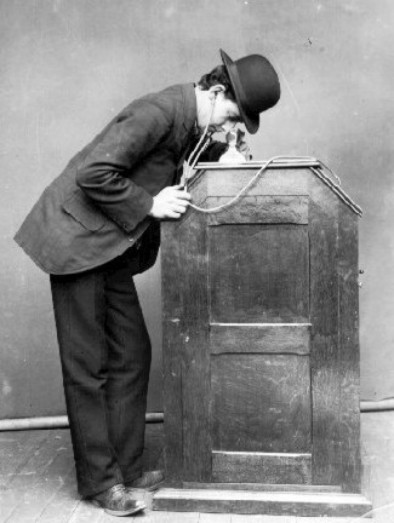What is Persistence of Vision?
The Persistence of vision refers to the optical illusion where multiple images can blend into a single moving image, tricking the human mind to believe that it is in fact moving, this is the main explanation for motion perception in cinema and animated films.
However the persistence of vision can trick the human mind through various examples, for example swinging a light on a string would create a streak if the room were to be dark, but if the room were to be lighted as well you'd just see the light moving yet no streak would follow.
Another example would be spinning a double sided drawing, for example a name (my name for this example) on one side you put "Ja" and the other side would have "red" thus when you spin it, it'll give the illusion that the word is being spelt.
Examples of what is being said above - What is Persistence of Vision? (Mr. Wizard) https://www.youtube.com/watch?v=YismwdgMIRc
 What were the earlier devices used to create moving images in the Persistence of Vision?
Zoetrope
What were the earlier devices used to create moving images in the Persistence of Vision?
Zoetrope
A Zoetrope is one of the several pre-film animation devices that produce the illusion of motion by displaying a sequence of drawings or photographs showing progressive phases of that motion.
What the zoetrope consists of is a cylinder with numerous vertical cuts around it, this allows for a numerous amount of people to look at it at once, the cylinder is placed on a dial and spun. The reason it is spun is because of the images inside the cylinder, there'll be about 20 different images that correlate to each other, thus when spun it creates the illusion of motion. A visual example of this would be from the image below and this YouTube video:
Things - Zoetrope -
https://www.youtube.com/watch?v=yD0ovANHdqQ
 Thaumatrope
Thaumatrope
The Thaumatrope consists of a disc with a different picture on each side, for example a bird on one side and a cage on the other, with the two images on both sides; the disk will be spun rapidly blend the two images together or create a short moving image. Following on from the example when the disk is spun the image of the bird and the cage would blend together creating the illusion that the bird is in the cage. A visual example of this would be from the image below and this YouTube video:
Thaumatrope: Bird & Cage - https://www.youtube.com/watch?v=yD0ovANHdqQ
 Phénakistoscope
Phénakistoscope
A phénakistoscope was the first widespread animation device that creates another illusion of motion. This method is on a large disk, the disk would have small cuts all around it, separating it so that the images drawn correlate with each other onto each section of the disk. Then the disk would be placed on a device where the viewer can manually spin via a dial, then the speed of the image being spun would create the illusion of animation.
Film Before Film - Phenakistoscope, Zootrope, Praxinoscope - https://www.youtube.com/watch?v=r4B3FHHt_k8

 Kinetoscope
Kinetoscope
Invented in 1891 by Thomas A. Edison and William Dickson. The Kinetoscope has a strip of film inside it which was passed rapidly between a lens and a light bulb to display the image as the viewer peered through the peephole.
The Kinetoscope -
https://www.youtube.com/watch?v=sfI0NVC0hLU

 Mutoscope
Mutoscope
The Mutoscope is a larger and more advanced version of the Phénakistoscope and an alternative to the Kinetoscope, being an early motion picture device invented by Winsor McCay, it did not project onto a screen and provided viewing to only one person at a tine throw a viewfinder.
Mutoscope Mechanism -
https://www.youtube.com/watch?v=k-U4hmLe2tc
.jpg/220px-Mutoscope,_1899_(bis).jpg)




















_Gertie_on_Tour.webm/220px-seek%3D15-Winsor_McCay_(1921)_Gertie_on_Tour.webm.jpg)







.jpg/220px-Mutoscope,_1899_(bis).jpg)